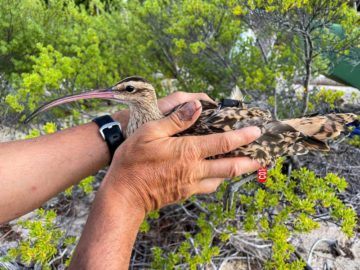Jason Gregg in Smithsonian:
 Five years ago, French navy officer Jérôme Chardon was listening to a radio program about the extraordinary journey of the bar-tailed godwit, a bird that migrates 14,000 kilometers between New Zealand and Alaska. In his job as the coordinator of rescue operations across Southeast Asia and French Polynesia, Chardon understood better than most how treacherous the journey would be, as ferocious storms frequently disrupt Pacific island communities. Yet, somehow, bar-tailed godwits routinely pass through the area unscathed. Chardon wondered whether learning how godwits navigate could help coastal communities avoid disaster. Could tracking birds help save lives?
Five years ago, French navy officer Jérôme Chardon was listening to a radio program about the extraordinary journey of the bar-tailed godwit, a bird that migrates 14,000 kilometers between New Zealand and Alaska. In his job as the coordinator of rescue operations across Southeast Asia and French Polynesia, Chardon understood better than most how treacherous the journey would be, as ferocious storms frequently disrupt Pacific island communities. Yet, somehow, bar-tailed godwits routinely pass through the area unscathed. Chardon wondered whether learning how godwits navigate could help coastal communities avoid disaster. Could tracking birds help save lives?
This past January, a team from France’s National Museum of Natural History (NMNH), funded primarily by the French Ministry for the Armed Forces, began experiments designed to test Chardon’s idea. Researchers with the new Kivi Kuaka project, led by Frédéric Jiguet, an ornithologist at NMNH, equipped 56 birds of five species with cutting-edge animal tracking technology. The French navy ferried the team to remote atolls and islands in French Polynesia, where the scientists attached tags using ICARUS tracking technology. These tags transmit the birds’ locations to the International Space Station, which bounces the data back to scientists on Earth who can then follow the birds as they forage, migrate, and rest—all the while waiting to see how the birds respond to natural disasters.
More here.
